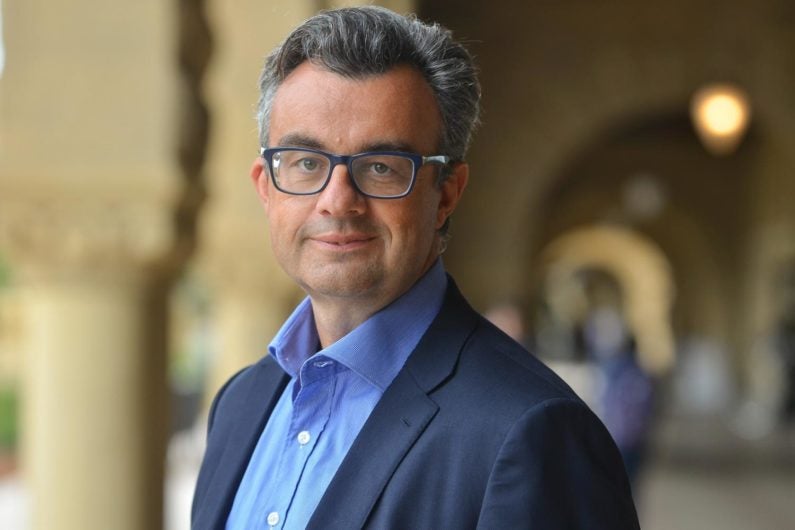Emmanuel Candès wins a MacArthur grant
A mathematician and statistician, Emmanuel Candès developed algorithms that significantly speed the process of generating high-resolution images for medicine and scientific data processing. His work has earned him a so-called “genius grant.”

Emmanuel Candes (Image credit: Rod Searcey)
Emmanuel Candès, the Barnum-Simons Chair in Mathematics and Statistics and chair of statistics, has been named one of the 2017 fellows of the John D. and Catherine T. MacArthur Foundation.
The fellowships, also referred to as “genius grants,” recognize individuals who show “exceptional originality in and dedication to their creative pursuits.” Fellows receive $625,000 stipends that come with no conditions in order to inspire recipients to “pursue their own creative interests.”
“The ability to harness and analyze big data will transform our lives, and Emmanuel Candès has been on the forefront of this revolution – discovering algorithms to faithfully reconstruct images from incomplete data,” said Stanford President Marc Tessier-Lavigne. “The future applications of his work will influence everything from medical imaging to cloud computing. We are thrilled that Emmanuel’s work has been recognized by the MacArthur Foundation with this honor.”
Candès studies applied mathematics with an emphasis on signal processing, medical imaging and statistics. He learned that he’d won the award during a phone conversation about a month ago, and was only allowed to tell one person.
“I told my wife – she thought I was joking,” he said. “I feel very grateful that some of my colleagues obviously nominated me for this, and I feel tremendously honored that they thought I was worthy.”
David Donoho, a professor of statistics, has known Candès since he was a graduate student at Stanford.
“He’s a person who’s very, very respected across the whole spectrum of the mathematical sciences – people in pure math, in applied math, in statistics, in computer science – they know his name,” Donoho said. “And in each of those fields, they know by heart specific papers that he’s written and they have been very inspired by his work.”
Candès said he hopes to use the grant to pursue new avenues in statistics in the face of big data. “I think it’s a very exciting time for statisticians to rethink the foundation of statistical science so that we have tools adapted to the way in which people now approach science, which is this: collect data first and ask questions later, rather than the other way around. The kind of statistical tools we now need is very different from those developed in a world where data was scarce.”
High-quality images from less
Candès is best known for developing compressed sensing – a set of algorithms that radically speed the process of acquiring and processing high-resolution images, with implications for everything from medical imaging to intelligence gathering.
Ordinarily, collecting high-resolution images involved gathering massive amounts of data in order to improve the image quality, but Candès and his colleagues had what might seem like a counterintuitive idea: collect less data, then fill in the missing parts. It works by sampling only a fraction of what a camera’s digital sensor could collect. Compressed sensing algorithms then fill in the empty space based on the color of pixels it did collect.
Although there’s no iron-clad guarantee compressed sensing will recover a good image, it almost always does because most images change fairly smoothly from one pixel to the next. A face, for example, doesn’t generally vary much in hue or tone, except at a few boundaries, such as the eyes, the mouth or the nose.
One of the earliest applications of this work was in pediatric MRIs, which could take up to minutes. In some cases, however, just a single heart beat can shake a child enough to blur an MRI – and the usual solution is to stop that child’s heart long enough to take an image. By cutting the exposure time to less than a minute, compressed sensing decreased the length of time doctors would need to stop a child’s heart. Other important, albeit less dramatic, applications include faster, higher resolution digital cameras and spying algorithms that can defeat efforts to scramble radio communications.
Candès is also well know for techniques called matrix completion and super-resolution microscopy, both of which also infer greater detail from data. The first can help Netflix and other internet companies infer giant matrices of consumer behavior from sparse observations. The second is a microscopy technique that produces images of molecular structure at scales that surpass traditional optical limits.
Bright and fearless
Candès earned his Diplome d’Ingénieur from Ecole Polytechnique and his PhD from Stanford. He joined Stanford as an assistant professor of statistics in 1998, leaving in 2000 to join the faculty at Caltech. He returned to Stanford in 2009.
As a graduate student, Candès worked with Donoho, who described Candès as “this big lovable guy who is also piercingly smart.” Donoho took Candès with him on a work trip to Israel and recalls Candès smiling, staring up at magnificent walls of landmarks. “I think that’s kind of an emblem of what he was like as a graduate student: strong, fearless and happy to attack challenges and go after the unknown.”
Recently, Candès was named the winner of the Ralph E. Kleinman Prize by the Society for Industrial and Applied Mathematics. He’s a fellow of the American Academy of Arts and Sciences and a member of the National Academy of Sciences. He is also a professor of electrical engineering, by courtesy, and a member of the Institute of Computational and Mathematical Engineering.
